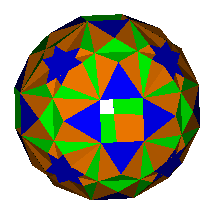
Canonical Toroids
"A polyhedron is said to be canonical if all its polyhedron edges touch a sphere and the center of gravity of their contact points is the center of that sphere." (http://mathworld.wolfram.com/CanonicalPolyhedron.html)
Many polyhedra are canonical: All uniform polyhedra have this property as do some Johnson Solids. It is also fairly easy to generate a toroid with regular faces and visible holes which is canonical. A number can be formed by taking two superposed copies of an archimedian polyhedron and gyrating one with regard to the other. An example formed from a truncated dodecahedron is linked here (frame). The required property is that the polyhedron contains 2n-gons but only an n-fold symmetry axis through the centre of these polygons. More regular faced canonical toroids have been discovered by Dr Richard Klitzing in his facetings of the uniform polyhedra, an example being this 'ike-6-6-a' (frame), a faceting of the icosahedron. Dr Klitzing's images are hosted by Ulrich Mikloweit here
All of the above toroids have at best a dihedral symmetry. I was surprised to discover three examples of regular faced canonical toroids with visible holes and a higher degree of symmetry, all three exhibit octahedral symmetry.
Octahedral Toroid from Small Rhombicosidodecahedra
Consider two superposed small rhombicosidodecahedra. Consider also the 2-fold symmetry axis that passes though opposing square faces. Gyrate one small rhombicosidodecahedron through 90 degrees with respect to the other. The two opposing square faces again coincide and can be removed. If we examine the square faces of a small rhombicosidodecahedron we see that they lie in the face planes of a triacontahedron. These are also the face planes of a compound of five cubes. This means that when one small rhombicosidodecahedron is rotated then four further pairs of square faces also coincide, leaving a canonical toroid of genus 5 with six square openings and octahedral symmetry.
Octahedral Toroid from Truncated Icosidodecahedra
The generation of this toroid follows the same path as the small rhombicosidodecahedral example above, replacing the small rhombicosidodecahedra with truncated icosidodecahedra.
Octahedral Toroid from Truncated Cuboctahedra
The generation of this toroid is more complicated than the above two examples and involves four truncated cuboctahedra. Start by considering two superposed truncated cuboctahedra. Consider also the 4-fold symmetry axis that passes though opposing octagonal faces. Gyrate one truncated cuboctahedron through 45 degrees with respect to the other. The two opposing octagonal faces again coincide and can be removed. Note that four of the square faces of the gyrated truncated cuboctahedron now lie above the remaining octagonal faces of the original truncated cuboctahedron.
If we repeat the exercise twice more to remove the remaining four octagonal faces of the original truncated cuboctahedron we find that we have twelve square faces lying in coincident pairs above each of the six original octagonal faces. These can also be removed to leave a canonical toroid with six square openings and octahedral symmetry. The toroid is non-orientable (one-sided) and has a genus of 18.
An interesting model can be generated if each face is coloured according to the truncated cuboctahedron from which it originates. The right hand image above shows such a model. The original truncated cuboctahedron is shown in red with the gyrated polyhedra in yellow, green and blue.
Credits
The polyhedra on this page were generated using HEDRON. The discovery and examination of these figures was made possible by Robert Webb's Great Stella program.
For users of Great Stella: Stella files of all these polyhedra are included in this archive: canonical.zip
Back: To Toroids
Back:
To Index